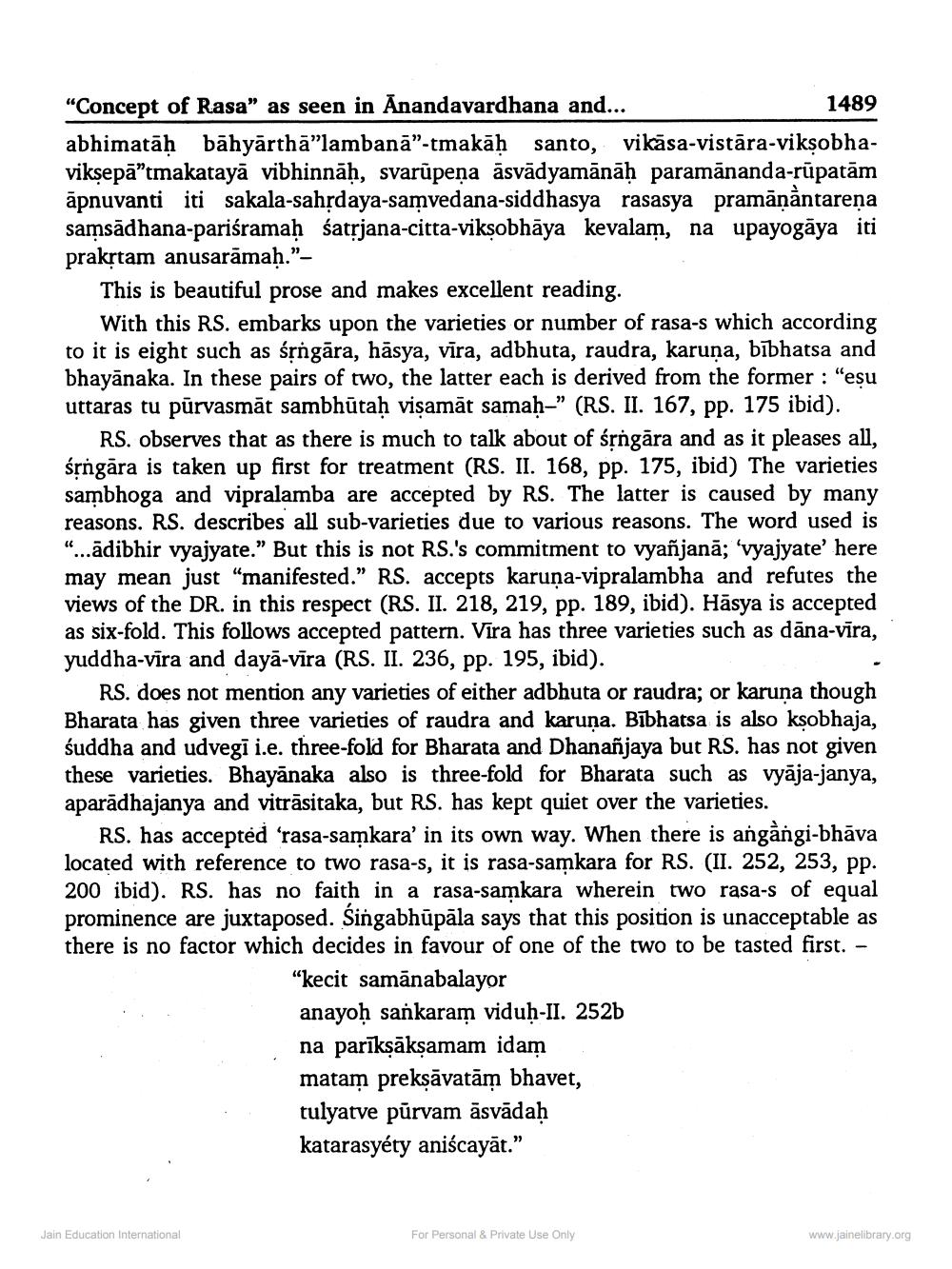________________
"Concept of Rasa” as seen in Anandavardhana and..
1489 abhimatāḥ bāhyārthā”lambanā”-tmakāh santo, vikāsa-vistāra-viksobhaviksepā”tmakatayā vibhinnāḥ, svarūpena āsvādyamānāh paramānanda-rūpatām āpnuvanti iti sakala-sahrdaya-samvedana-siddhasya rasasya pramă rena samsādhana-pariśramaḥ śatrjana-citta-viksobhāya kevalam, na upayogāya iti prakstam anusarāmaḥ.”
This is beautiful prose and makes excellent reading.
With this RS. embarks upon the varieties or number of rasa-s which according to it is eight such as śộngāra, hāsya, vīra, adbhuta, raudra, karuna, bībhatsa and bhayānaka. In these pairs of two, the latter each is derived from the former : "esu uttaras tu pūrvasmāt sambhūtah visamāt samah-” (RS. II. 167, pp. 175 ibid).
RS. observes that as there is much to talk about of śrngāra and as it pleases all, śộngāra is taken up first for treatment (RS. II. 168, pp. 175, ibid) The varieties sambhoga and vipralamba are accepted by RS. The latter is caused by many reasons. RS. describes all sub-varieties due to various reasons. The word used is "...adibhir vyajyate." But this is not RS.'s commitment to vyañjanā; 'vyajyate' here may mean just "manifested." RS. accepts karuna-vipralambha and refutes the views of the DR. in this respect (RS. II. 218, 219, pp. 189, ibid). Hāsya is accepted as six-fold. This follows accepted pattern. Vira has three varieties such as dāna-vīra, yuddha-vīra and dayā-vīra (RS. II. 236, pp. 195, ibid).
RS. does not mention any varieties of either adbhuta or raudra; or karuna though Bharata has given three varieties of raudra and karuņa. Bibhatsa is also ksobhaja, śuddha and udvegi i.e. three-fold for Bharata and Dhananjaya but RS. has not given these varieties. Bhayānaka also is three-fold for Bharata such as vyāja-janya, aparādhajanya and vitrāsitaka, but RS. has kept quiet over the varieties.
RS. has accepted 'rasa-samkara' in its own way. When there is angàngi-bhāva located with reference to two rasa-s, it is rasa-samkara for RS. (II. 252, 253, pp. 200 ibid). RS. has no faith in a rasa-samkara wherein two rasa-s of equal prominence are juxtaposed. Singabhūpāla says that this position is unacceptable as there is no factor which decides in favour of one of the two to be tasted first. -
"kecit samānabalayor anayoḥ sankaram viduh-II. 252b na parīkşākşamam idam matam prekṣāvatām bhavet, tulyatve pūrvam āsvādaḥ katarasyéty aniścayāt.”
Jain Education International
For Personal & Private Use Only
www.jainelibrary.org




